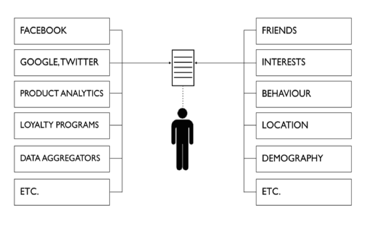Design futures 2: Personalization and the new product canvas

We are living through a time of rapid change which is having a fundamental impact on how we experience and design for the internet.
No one has all the answers about where this is leading but three key trends are starting to emerge: designing systems rather than destinations, designing for personalisation, and designing for change. This article discusses personalisation, is the second of three articles discussing these changes, and is based on a keynote I gave earlier this year at FOWD.
Designing for personalization is challenging because it involves designing experiences that look and act differently for every single person. This requires a deep understanding of how to create and use design patterns.
People used to often ask me if “social media” was a fad. Not only is it not temporary or trivial, it’s a fundamental re-architecture of how we build products on the Internet, and its emergence is a natural and obvious progression. Human beings are social animals and almost everything we do is oriented around other people. We don’t ask our friends to make their dinner party, camping trip or work meeting “social” so why would we do that with software? Talking about “social” in the abstract doesn’t make sense.
Whilst understanding social behavior is incredibly complex, there are two main things I think people need to understand to design personalized experiences.
- Identity. People want to feel unique.
- Connectedness. People want to feel connected to others.

Everyone has a deep desire to feel different and special. Every one of us is unique. We have unique preferences, opinions and desires. There is no one else on earth exactly like us. We need to know we have an individual and important place in the world. All of us want to feel this.

Somewhat paradoxically, we also need to feel we belong, that we are not alone in the world and that we are part of something larger. So much of our behaviour is oriented around connecting with other people, building relationships and allegiances.
These two ideas are critical to understanding the future of web design. Remember that initially the web was built around content, pages linked together. We built destinations. We “went online”. To a place. And those destinations looked the same for everyone who visited.
But that web is fast disappearing. Now anytime you are served data, whether that be a website or app, on any device, you bring data with you. Your friends, your interests, your past behaviour, even your friends’ interests.

If you decide to share that data, businesses can tailor what they offer to you. It can be personalised, matched to how you think about your unique identity, and helping you connect with others who like similar things.
Let’s look at some examples. What does news look like in this world?

It looks like this. This is clearly a better experience for you, as rather than have an editor who knows nothing of your interests select what they think you should see, you see things you’re interested in. This is also better for the news provider as the likelihood is that every important engagement metric will rise in this world: time spent, things clicked, read, shared etc.
This will change other media such as TV – Netflix is already providing uniquely personalized experiences and has more subscribers than any of the major US cable providers – and it is already impacting how we buy products and services.

This is also already happening in bricks and mortar stores. Safeway provide different prices depending on whether you are in their loyalty program, and Target deliver uniquely personalised direct mail based on your past purchase history, and savings based on sharing coupons with friends.
Many people underestimate the extent to which personalization is already happening online. If you are signed into Google you will see different search results than others based on your past searches and websites you’ve visited, but the remarkable thing is that this happens even if you are not signed in (using cookies).

So our new product canvas is a system, not a destination. The incredible rise of mobile technologies, APIs, SDKs, and open partnerships between platforms and products paints a crystal clear picture of a future where we will all design personalised experiences. Designing static, linked web pages is a dying profession. PDFs full of wireframes are a dying deliverable, Photoshop is a dying product design tool. More on Photoshop in the third and final article in this series.
This is the second of three articles discussing these three changes, based on a keynote I gave earlier this year at FOWD. Check out the first: designing systems rather than destinations






